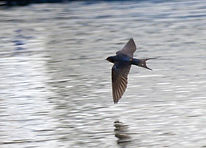
Cookham Swallows and House Martins survey

Photo: Graham Parkinson
WildCookham carried out its first Swallows and House Martins survey in the summer of 2021. The aim was to establish where these summer visitors are nesting locally: this might allow us to develop plans for creating more sites and provide other encouragement, to stem falling numbers of these iconic birds.
We divided Cookham up with a team of Swallow Spotters covering the whole parish – reporting swallows and house martins in flight, nests found and numbers and fledging dates of the young. Although we have found some nesting sites, this has proved tricky as spotting a trio (or more) of birds in flight doesn’t always lead you to their nests!


Swallow (photo: Wiki Commons)
Young House Martins (photo: Wiki Commons)
Survey results
The season started slowly with a wet May delaying the return of both species. However, from 3rd June swallows were seen all around the village, especially in numbers under Cookham bridge. Thanks to a boat-owning spotter, the nests under the bridge were checked on 15th June, and we counted 17 nests. Swallows were in and out under the bridge all the time. Another check on 5th July showed fledglings peeping out of nests and being fed, and young perching on the girders.
Another regular swallow nest site is on Winter Hill Road where they were observed inspecting existing nests on 5th June and went on to lay here, were seen feeding on 22nd, then fledged around 1st July. At Hindhay Farm, swallows were seen flying and inspecting nests in a barn on 10/11th June. There are four old nests there so we were hopeful. In the event just one pair nested, and only once: on 27th June three young were seen wing stretching, followed a couple of days later by more energetic fluttering, and the sight of a fourth, but still inside. They had fledged by 7th July (probably a day or so earlier) and, by the following day, six Swallows (parents and young) were flying outside.
Other swallow nesting sites were seen at Hardings Farm, White Place Farm, the old Cricket Common in Cookham Dean, and at stables in Strande Lane. The overall picture suggests that swallows are still coming to Cookham but numbers are falling and the weather this year was a likely factor in continuing decline. We had plentiful views of swallows but the late arrival of summer clearly impacted nesting with fewer birds laying eggs and little evidence of second broods.
The highlight with the House Martin study was the realisation that there is a significant colony nesting at the Odney Club – more than 20 nests on one building. Fledglings were seen flying from these by 4th July. Several nests were also found by the old Cricket Common and near St John the Baptist church in Cookham Dean. These site offer the potential for plans to extend these colonies with additional artificial nests nearby.
2022 plans
-
We plan to repeat the survey on a more comprehensive basis, learning from the experience in the past summer
-
We are now looking at other possible swallow nesting sites across Cookham. These could be farm buildings, barns, outhouses as well as buildings related to horse paddocks – loose boxes, shelters etc. We then plan to approach the relevant landowners to discuss both the local habitats near these structures and steps that can be taken to improve them and also we are exploring the possibility of putting up artificial swallow nests.
-
We are looking at the area immediately around the Odney Club to see if local residents are prepared to install artificial martin nests with a view to branching out from the existing large colony.
Can you help?
Contact us at wildcookham@cookham.com if you would like to join our survey team in summer 2022 or are interested in installing an artificial swallow or house martin nest.
The regional and national context
The Berkshire Ornithological Club reported for House Martins in 2021:
In contrast to the advance of our Peregrine population, House Martins, at least in Reading, seem to have had a hard time in 2021. A survey organised by Sarah White for the RDNHS (Reading and District Natural History Society) found no nesting House Martin in eleven 1km squares that had been occupied in a previous survey. Only one site in Reading was found to have them in 2021, though nesting was not confirmed. Let’s hope 2022 will be a better year for this delightful species.
And the story for Swallows at a national level?
Whilst the first UK recorded Swallow arrival of 2021 on Feb 16th (Ruan Minor, Cornwall) was a reasonably seasonal date, what followed was a long delay compared to most years before the bulk of our estimated population of c700,000 pairs arrived on their territories. In Berkshire, it was not until 28th March that ‘our’ first one arrived, and even after that, birds were only seen as singles until the first week of April. Once here in numbers, as shown in the Birds of Berkshire (2013), Swallows have regularly nested in up to 86% of the county’s tetrads (2km squares). But in 2021, the unusual spring weather greatly reduced numbers of aerial insects, which will have affected the success rate for those that attempted to breed.


Artificial nests - Swallow (above),
House Martin (below)
And our thanks to the volunteers for the 2021 survey - Andrew Padmore, Andy Blair, Ann Greenwood, Biddy Palmer, Brian Clews, Gail Perera, Graham Parkinson, Helen Moss, Helen West, Jill Pockett, Joelle Hewson, Kira Holland, Lizzie Maillard, Mike Copland, Sara Lloyd Parry, Sherry Smith, Stephanie Papillon, Zara Porter-Hill

Swallow and House Martin sightings and nests - Summer 2021
There's a more detailed map of the sightings here. Click on the icons on that map to get the detail.
Our Swallows and House Martins in action
Photos by local photographer Graham Parkinson




House Martins above and left; Swallows below



